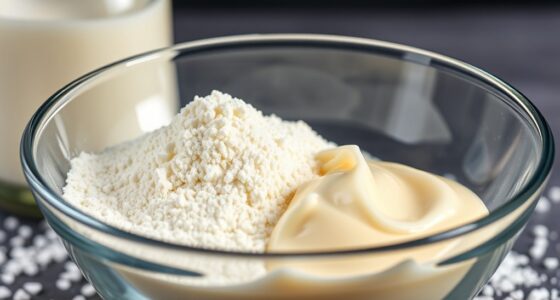To keep your low sugar ice cream smooth without sucrose, use sugar substitutes like erythritol or stevia that mimic sweetness and help prevent ice crystal formation. Incorporate stabilizers such as guar gum or xanthan gum to improve texture and prevent graininess. Chilling the mixture thoroughly before churning, then allowing the ice cream to rest in the freezer, will enhance scoopability. Want more tips to perfect your creamy treat? Keep exploring, and you’ll find all the tricks you need.
Key Takeaways
- Incorporate sugar substitutes like erythritol or stevia that mimic sweetness and help maintain a smooth texture.
- Use stabilizers such as guar gum or xanthan gum to inhibit ice crystal growth and ensure creaminess.
- Chill the mixture thoroughly before churning to promote even freezing and a silky consistency.
- Add a small amount of alcohol, like vodka, to lower freezing point and improve softness without affecting flavor.
- Experiment with different ingredient ratios and blend thoroughly for uniform, smooth ice cream without relying on sucrose.

Have you ever wondered if you can enjoy ice cream without the sugar crash? The good news is, you can, by choosing low sugar options that still deliver that creamy, satisfying texture you crave. When reducing sugar in ice cream, one of the biggest challenges is maintaining the smoothness and creaminess that make it so enjoyable. That’s where sugar alternatives come into play. These substitutes, like erythritol, monk fruit, or stevia, can mimic the sweetness of sugar without spiking your blood sugar levels. But it’s not just about sweetness; it’s also about preserving texture. Sugar plays a vital role in ice cream because it lowers the freezing point of the mixture, ensuring it’s scoopable and smooth. Without it, your ice cream might turn out icy or grainy, which no one wants.
To combat this, many recipes incorporate sugar alternatives that help preserve texture. For example, erythritol has a similar sweetening power and can help keep ice cream soft and scoopable. Some people also add small amounts of alcohol, like vodka, which doesn’t freeze and can improve mouthfeel. Additionally, stabilizers such as guar gum or xanthan gum are often used in low sugar recipes. They help prevent ice crystal formation and keep the ice cream creamy. These ingredients work together to mimic the properties of sugar, ensuring that even with reduced sweetness, your ice cream remains irresistibly smooth.
It’s important to experiment with different combinations of sugar alternatives and stabilizers to find the perfect balance for your taste and texture preferences. Some sugar substitutes may add a slight aftertaste or affect the consistency, so starting with small batches can be helpful. Also, blending ingredients thoroughly and allowing the mixture to chill properly before churning can further improve texture. Remember, patience is key—sometimes, letting your ice cream sit in the freezer for a few hours after churning helps it develop a more refined, scoopable consistency.
Frequently Asked Questions
What Natural Sweeteners Are Best for Low Sugar Ice Cream?
You should consider natural sweeteners like stevia, monk fruit, and erythritol for your low sugar ice cream. These sugar substitutes provide sweetness without the added calories or blood sugar spikes, helping maintain a smooth texture. Stevia and monk fruit are particularly popular for their natural origins, while erythritol offers a clean, cooling finish. Using these options, you can enjoy a creamy, sweet treat while keeping sugar levels low.
How Does Sugar Reduction Affect Ice Cream Shelf Life?
Reducing sugar in ice cream shortens its shelf life because it affects microbial stability and preservation. Without enough sugar, harmful bacteria and mold can grow faster, risking spoilage. You’ll need to implement alternative preservation methods like natural antimicrobials or proper packaging. While lower sugar can enhance health, it demands extra care to guarantee your ice cream stays safe and fresh longer, balancing health benefits with shelf life implications.
Can Low Sugar Ice Cream Be Suitable for All Dietary Restrictions?
Low sugar ice cream can be suitable for many dietary restrictions if you choose appropriate ingredient substitutions. You need to contemplate allergies, gluten intolerance, or lactose sensitivity and select alternatives like dairy-free milk or natural sweeteners. Always read labels carefully, as some ingredient substitutions may not meet specific dietary needs. With mindful choices, you can enjoy low sugar ice cream that aligns with various dietary restrictions and preferences.
What Are the Best Techniques to Improve Texture Without Sugar?
Imagine a silky river flowing smoothly; that’s the goal for your low sugar ice cream. To improve texture without sugar, focus on techniques like adding cream or healthy fats to enhance creaminess preservation. Incorporate stabilizers like gelatin or guar gum for better texture enhancement and to prevent ice crystal formation. Churning thoroughly and using alternative sweeteners like stevia or erythritol also help maintain that indulgent, smooth consistency you crave.
Are There Specific Flavor Profiles That Work Better With Less Sugar?
You’ll find that fruit pairings and spice enhancements work better with less sugar, as they naturally boost flavor without overpowering sweetness. Incorporate tart berries or tropical fruits for vibrant profiles, and add spices like cinnamon or ginger to deepen the flavor. These combinations create a balanced, appealing taste that compensates for reduced sugar, making your low sugar ice cream satisfying and delicious without sacrificing complexity or richness.
Conclusion
Now that you know how to keep your low sugar ice cream smooth without sucrose, it’s all about choosing the right ingredients and techniques. Don’t forget, even the most ancient recipes relied on natural thickeners—think honey or fruit purées—to achieve perfect texture. So, embrace these tips, get creative, and enjoy a delicious, guilt-free treat. After all, as the wise Socrates might say, “Know thy ingredients,” and you’ll never go wrong!










